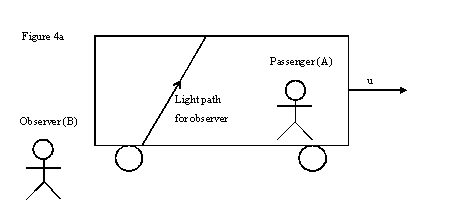Judgement Day (21 page)
Authors: Michael Spears
Tags: #apocalypse, #messiah, #armageddon, #last days, #judgment day, #judgement day

(18)
Crunching the numbers
for the two equations, using the deflection of a beam of light
travelling around a point mass of one solar mass at a distance of
one solar radius from the centre of mass gives, for equation (17) a
value for the deflection angle of 0.875669arcseconds, while
equation (18) gives a very slightly smaller value of
0.875666arcseconds. You might also notice that equation (18)
collapses when the value for ‘d’ is inside the Schwarzschild
radius, which should be expected since when a beam of light passes
within the Schwarzschild radius it is believed to be sucked into
the black hole, not merely have its angle deflected to a finite
amount.
Although not a
complete derivation, because I have assumed that the beam of light
does not get any closer as a result of its gravitational deflection
to the object of mass it is passing, the above should help to show
that my theory should be able to account for everything that
Einstein did if it is properly applied.
Part 2: Visualising Gravity In Four
Dimensions
Part 2a: The Curvature
Of Space
Einstein proposed that spacetime is warped by mass
to create gravity, I shall expand on this idea below, however
rather than refer to “spacetime” I shall refer simply to
“space”.
Imagine the effect of an object of mass on a
two-dimensional
plane of
space in one dimension,
and let
us draw a cross-section of said plane of space.
A
ssume that space is repulsed by
mass, or assume that mass repulses space
, as first proposed by Einstein.
[Figure
2a]
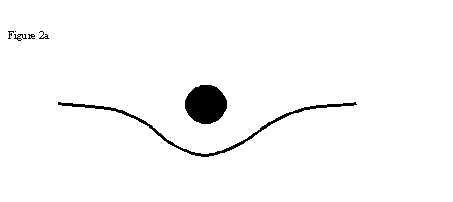
Of course, there
wouldn’t be just one plane of space in all of space, there should
theoretically be an infinite number of these planes, so let’s
extend the idea. [Figure 2b]
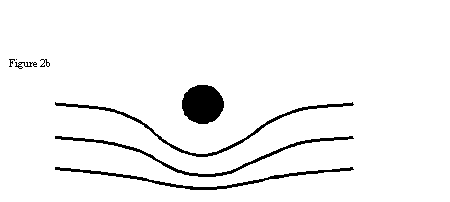
Next we must take into
consideration that space is not one dimensional but three
dimensional, so let’s imagine space being repulsed by mass in every
direction at once. [Figure 2c]
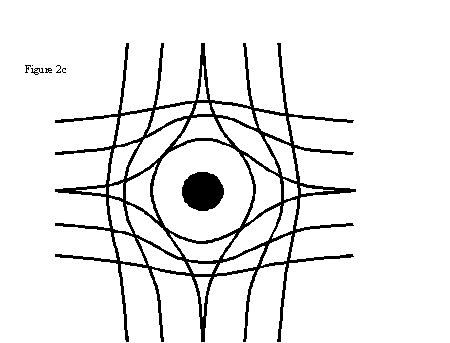
Therefore the net
effect of space being repulsed by mass in every direction at once
would be something like this. [Figure 2d]
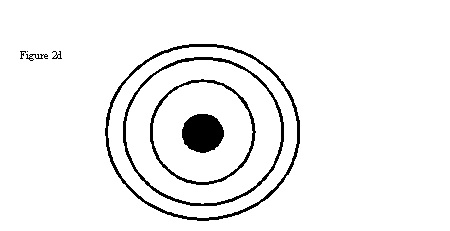
According to the above
diagrams, the net effect of space being repulsed by mass in every
direction at once would create something of a “density of space”.
In order for space to have a density there is no need to invent an
æther to fill space, the curvature of space can create the effect
of a density of space without the need for an æther to fill the
voids.
Let’s now expand on
this idea of an infinite number of planes of space being repulsed
by mass.
Part 2b: Space And
Mass
Next we’ll examine
what would happen as an object of mass moves through space, let’s
visualise the situation. Although these theoretical planes of space
themselves would not move, the curvature of space would be pushed
forwards as an object of mass moves through space and space would
be pushing the object of mass from behind. Since every action force
has an equal and opposite reaction force, while mass pushes on
space, space also pushes on mass. [Figure 3]
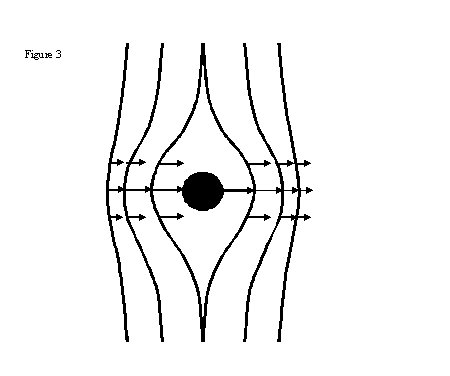
Therefore, when an
object of mass is in motion space would essentially move with it.
While it would take energy to set an object of mass in motion, due
to the need to move the space with it, once that object of mass is
in motion it would continue to move through space. An object of
mass must push space forward to move through it, but space pushing
the object of mass from behind ensures that the object continues to
move forward and the law of inertia can thus be visualised. If
space offered no resistance to the forward motion of mass then mass
must always move at its maximum velocity, which we know to be light
speed, having to set space in motion would require a specific
amount of energy, the amount of energy required would be determined
by how much space needs to be moved.
What is mass? We know
from Part 1 that mass is not constant but is dependent on the
gravitational field strength that mass resides in, from Part 2a we
know that the gravitational field strength is determined by the
density of space, and from above we know that the energy required
to set an object in motion is determined by how much space needs to
be “pushed out of the way”. We could decide that mass is a measure
of the effect an object has on the curvature of space. What is it
about mass that causes space to warp? The traditional view is that
space-time is repulsed by mass, but we also know that mass and
energy are related, so perhaps we could take a new perspective and
imagine that mass is the effect of an energy field that warps
space. The greater the strength of this “mass energy” field, the
greater the mass. In nuclear reactions “mass energy” could be
converted to other forms of energy. The interchangeability of mass
and energy was first proposed by Einstein with the equation
E=mc
2
but now we can understand for the first time why
mass is not entirely separate from energy, mass is simply the
effect of an energy field that warps space and is itself a measure
of the energy required to move an object through space.
If mass is a measure
of the energy required to move an object through space, and the
greater the mass the greater the “mass energy” field surrounding
that object, then objects with greater “mass energy” fields
surrounding them would require more energy to set planes of space
in motion.
Why could an object of
mass move faster through denser regions of space? Perhaps in
regions of denser space the time taken for one plane of space to
push on the next plane of space is reduced because the planes of
space are closer together. Perhaps the transfer of energy from one
plane of space to the next is limited to the maximum value of light
speed, these planes of space can push on each other no faster than
light speed, with light speed being dependent on how close together
these planes of space are.
Why is mass not
conserved when moving through different densities of space? If mass
is simply a measure of the energy required to move an object
through space, and an object of mass moves into a region of space
where motion through this space requires less energy, then
naturally the mass would be less. In this situation mass may not be
conserved, but the strength of the “mass energy” field being
emitted by an object is conserved. Thus “mass energy” is conserved,
however mass is not.
How does gravitational
acceleration work? Let’s consider Figure 3 again and think about
what would happen if there was more space on one side of an object
of mass than the other. Every action force has an equal and
opposite reaction force, so while mass pushes on space, space also
pushes on mass. If space on either side of an object of mass was
unbalanced, one could therefore expect that the side with more
space would push the object of mass towards a region where there is
less space. Thus objects of mass would be pushed by unbalanced
space towards less dense regions of space, i.e. objects of mass
would be pushed by the force known as “gravity” from weaker
gravitational fields towards stronger gravitational fields. Gravity
has long been considered a weak force, and it has also been shown
that a large amount of energy is required to make a small amount of
mass. The weakness of gravity can now be understood, consider the
amount of energy that must be required to warp space, and consider
also that gravity is the effect of unbalanced space on either side
of an object of mass, then it is little wonder that so much energy
is required to create the mass which is required to make so little
gravitational force. In the context of my theory, gravity does not
seem so weak after all, but is the effect of an energy field that
warps the fabric of space itself!
Part 2c: Space And
Electromagnetic Radiation
It has long been
assumed that the constancy of light is explained by the Lorentz
transforms, however this may not be the case. Let’s consider one of
Einstein’s thought experiments, commonly found in textbooks, the
thought experiment involving a light pulse on a train moving close
to the speed of light. [Figure 4a]
